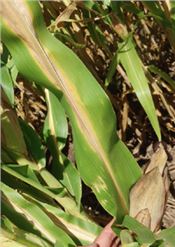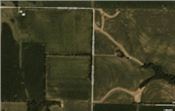Nitrogen Deficiency In 2017 Had A Long Fuse

Corn ear and V-shaped nitrogen burn up the midrib of the ear leaf.
Monroe County Missouri, August 23, 2017.
DR. PETER C. SCHARF
COLUMBIA, MO.
Based on a drive across northern Missouri on August 22-23, I would say that we lost quite a bit of corn yield to N deficiency this year. In northeast Missouri (Shelbina to Columbia), about half of the fields were affected, and in northwest Missouri (Corning to Brookfield), it was closer to a quarter. I only saw a few fields where the deficiency was widespread (more than half of what I could see), but it was often a quarter of what I could see or more.
I stopped in about a dozen fields and in all of them found the classic V-shaped burn up the midrib of lower leaves. I don’t mind seeing N burn in late August as long as it's not above the knee, but in most cases it was on the leaf below the ear leaf, and in a few cases was even on the ear leaf. I’m pretty sure that this is associated with yield loss – and an amount that you would care about.
It was a sneaky year for N loss. After a dry winter, a couple of big systems in late April and early May saturated the soils. I don't think we lost much N at that time, but it set us up for gradual loss with the normal rains that we had through the rest of May and June. I saw some N stress in May and June, but it was nothing like 2015 (or 2013 or 2010 or 2009 or 2008). I don't think the yield losses we ended up with were anything like those years either. But the yield losses we had mean that those who applied N in-season (either rescue or planned) should come out ahead of most of their neighbors who put all their N down before planting.
A new tool that can help with tracking what is going on with N loss is Planet satellites. Planet launched 88 shoe-box-sized satellites in February. As a result, the frequency of the images that they supply went way up in May and June as those satellites came online. Their Planet Explorer Beta version is available for free (at least for now) and lets you see frequent and recent images (signup required). I have a company, NVision Ag, that predicts yield loss and creates fertilizer control files based on aerial images; this year, nearly all of our products were created from Planet satellite imagery.
Mid-August Planet satellite images show that quite a few fields have N deficiency in northeast Missouri. Frequent imagery will, in the future, help us to catch and correct these deficiencies as they develop. ∆
DR. PETER C. SCHARF: Assistant Professor and State Extension Nutrient Management Specialist, University of Missouri

August 19 satellite image of fields with severe N stress in Monroe
County, Missouri. Most fields look better than these,
but many have visible N stress.